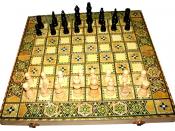The queen on a chess board is the most
powerful piece. From one square, the queen can
attack anywhere around it in a straight line
without skipping squares (as the diagram
illustrates on the right). The squares where the
arrow cuts through are the ones the queen can
attack and the queen can carry on attacking in
those straight lines. However the queen can't jump squares to attack,
these squares are marked with an x.
I will carry out my task systematically, drawing chess grids smallest to largest.
*2 by 2*4 by 4*6 by 6*8 by 8
*3 by 3*5 by 5*7 by 7*9 by 9
I will display how many places a queen can attack from a given square by writing the attacked amount in the square from were she attacked.
Table
Chess Board SizeSquares attacked from Layer
1234
2x23---
3x368--
4x4911--
5x5121416-
6x6151719-
7x718202224
8x821232527
9x924262830
From my table I notice an immediate trend.
As the chess board size increases all the attacked amounts increase by three and as the layers increase the attacked amount increases by two. I will attempt to find rules for these layers.
Layer 1
Chess board size(n)
2x23x34x45x56x67x7
Places attacked369121518
Difference33333
3n=3 x chess board size
6912151821
Places attacked - 3n-3-3-3-3-3-3
3n - 3
369121518
Layer 2
Chess board size(n)3x3
4x45x56x67x78x8
Places attacked81114172023
Difference
33333
3n91215182124
Places attacked - 3n
-1-1-1-1-1-1
3n - 1
81114172023
Layer 3
Chess board size(n)5x5
6x67x78x89x9
Places attacked1619222528
Difference3333
3n
1518212427
Places attacked - 3n11111
3n + 1
1619222528
Layer 4
Chess board size(n)7x7
8x89x9
Places attacked242730
Difference33
3n
212427
Places attacked - 3n333
3n + 3
242730
Graph explanation
I used my graph to support my linear rules. To plot the linear lines I used the method y = mx + c. Where m is the gradient...


